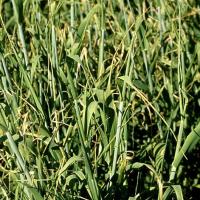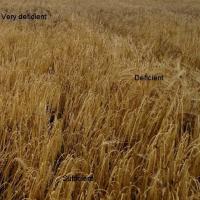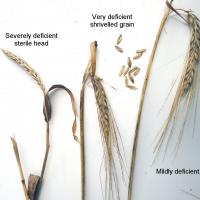Diagnosing copper deficiency in barley
Most soils in Western Australia were copper deficient in their natural state. Copper is essential for pollen formation and has a role in formation of chlorophyll and lignification (cell wall strength). Deficiency causes sterile pollen, which, in turn causes poor grain formation and high yield losses.
What to look for
- Before head emergence deficiency shows as areas of pale, wilted plants with dying new leaves in an otherwise green healthy crop.
- After head emergence mildly affected areas have disorganised wavy heads. Severe patches have white heads and discoloured late maturing plants.
- Symptoms are often worse on sandy or gravelly soils, where root pruning herbicides have been applied and recently limed paddocks.
Paddock
- Youngest growth is affected first and most severely.
- The first sign of copper deficiency before flowering is growing point death and tip withering, and/or bleaching and twisting of up to half the length of young leaves.
- The base of the leaf can remain green.
- Old leaves remain green and seemingly healthy.
- Tiller production may increase but they die prematurely.
- Heads may be white and withered or have a rat-tail appearance.
- Maturity is delayed and very late tillers may be present.
- Stems are weaker, although in less severe plants heads may be more erect. Severely deficient plants have few immature heads on weak and dirty stems.
Plant
What else could it be
| Condition | Similarities | Differences |
|---|---|---|
| Diagnosing molybdenum deficiency in cereals | White heads and shrivelled grain | The main difference is that molydenum deficiency affects middle leaves first rather than the youngest leaf |
| Diagnosing calcium deficiency in barley | Youngest leaf twisting and death | Calcium deficient plants are dark green rather than light green and fewer small heads rather than white heads |
| Diagnosing stem and head frost damage in cereals | White heads, shrivelled grain, late tillers and delayed maturity | Spring frost does not cause death or twisting of the flag leaf, and is worse in frost-prone areas |
| Diagnosing take-all in cereals | White heads and shrivelled grain | Take-all causes blackened roots and crowns, often killing plants |
Where does it occur?

Dry conditions

Spraying herbicide
- With the exception of loam or clay salmon gum or York-gum soils, most soils required copper and zinc when cleared for agriculture.
- Copper persists in soil but is relatively immobile and can become unavailable to crops in dry soil particularly in no-till systems.
- Copper deficiency can be induced by heavy liming; increased plant nitrogen status; use of zinc fertiliser; and use of root-pruning herbicides, particularly groups A and B.
Management strategies

Spraying foliar


Soil application

- Foliar spray (only effective in the current season) or drilled soil fertiliser.
- Copper foliar sprays are not effective after flowering as sufficient copper is required pre-flowering for fertile pollen development.
- As copper is immobile in the soil, topdressing is of little value, only being effective when the topsoil is wet.
- Mixing copper throughout the topsoil makes it more likely that roots can intercept the nutrient because soil at depth stays moist longer.
- In long term no-till paddocks fertiliser use via in-furrow application or seed treatment reduces the risk of plant roots not being able to obtain enough copper in dry seasons.
- Copper seed treatment is insufficient to for plant requirement in the current season.
How can it be monitored?

Soil test

Tissue test
- DTPA soil test and whole top plant test provide a rough guide for copper status.
- Use youngest emerged leaf to tissue test for copper levels with levels less than 1.6 milligrams per kilogram (mg/kg) indicating copper deficiency.
- Copper deficiency may be confirmed by grain test after sampling affected heads containing grain and unaffected heads from the crop.
See also
Further information
Where to go for expert help
Page last updated: Friday, 29 May 2015 - 2:06pm






